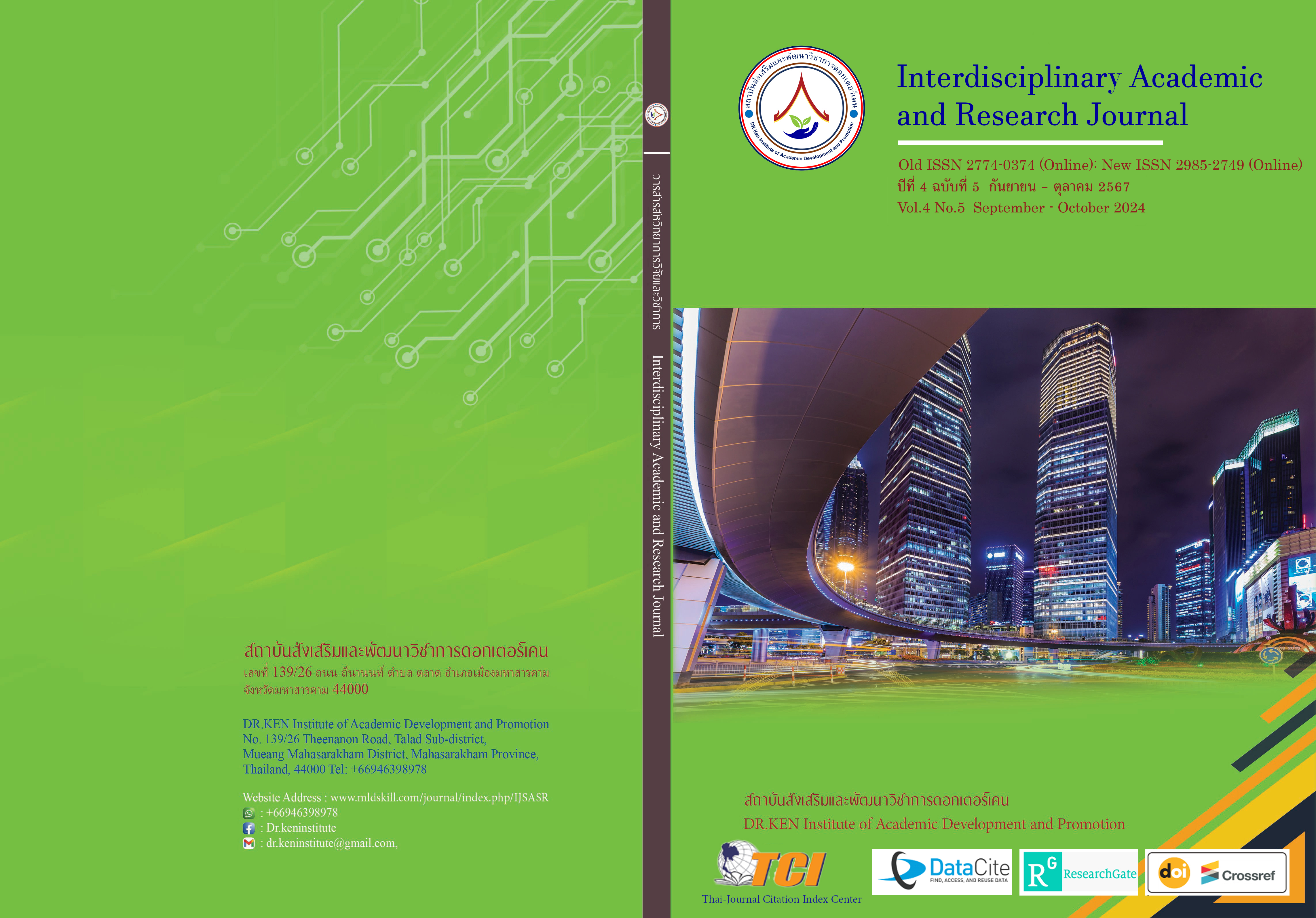Development of Augmented Reality Media to Promote Learning about Organic Farming
DOI:
https://doi.org/10.60027/iarj.2024.280212Keywords:
Augmented Reality Media; , Learning; , Organic FarmingAbstract
Background and Aims: The development of augmented reality (AR) media for organic farming education is critical because it provides interactive, immersive learning experiences that help students visualize complex concepts and techniques more effectively. This novel approach increases understanding and engagement, making organic farming more accessible and appealing. Thus, the purpose of this study was to: 1) create augmented reality (AR) media to promote learning about organic farming; 2) investigate the perception of AR media in promoting organic farming learning; and 3) assess satisfaction with AR media in promoting organic farming learning.
Methodology: The sample groups for this study were: 1) 10 key informants from the case study area, and 2) 100 farmers who visited the Yang Pho Khaen Community Enterprise Group in Hua Khwang Subdistrict, Kosum Phisai District, Maha Sarakham Province. The farmers were chosen through a purposive sampling method. The research tools included: 1) a semi-structured interview guide for key informants in the case study area; 2) augmented reality media to promote learning about organic farming; 3) a media quality assessment form evaluated by experts; and 4) perception and satisfaction assessments. The data were analyzed with mean and standard deviation statistics.
Results: The research findings are as follows: (1) Organic farming entails 1) organic planting and animal husbandry, 2) organic soil and water management, 3) organic pest control, and 4) the management of organic waste and reusable materials. (2) The development and evaluation of the quality of augmented reality media to promote learning about organic farming were conducted according to the design principles of the ADDIE Model, which consists of five major steps: 1) Analysis, 2) Design, 3) Development, 4) Application, and 5) Evaluation. (3) The media evaluation by experts revealed that the quality of the media was at the highest level, especially in terms of content, design, interaction, and presentation techniques, with a mean value of 4.84 and a standard deviation of 0.32, indicating the highest quality. (4) Farmers are the most aware of augmented reality media in organic farming, with a mean score of 4.71 and a standard deviation of 0.12. The results of each item examination revealed that all items demonstrated the highest level of awareness. Furthermore, the sample group reported the highest level of satisfaction with augmented reality media for organic farming, with a mean of 4.81 and a standard deviation of 0.05, indicating the highest level of satisfaction across all items. This augmented reality media produced positive results in terms of quality, awareness, and satisfaction from the sample group, confirming the media's effectiveness in effectively promoting learning about organic farming while also meeting the needs of the users.
References
กระทรวงเกษตรและสหกรณ์, กรมวิชาการเกษตร. (2537). มาตรฐานการผลิตพืชอินทรีย์ของประเทศไทย. กรุงเทพฯ: กระทรวงเกษตรและสหกรณ์, กรมวิชาการเกษตร.
จักรกฤช ใจรัศมี. (2559). การประยุกต์ใช้ทฤษฎีการปฏิสัมพันธ์ระหว่างมนุษย์และคอมพิวเตอร์เพื่อการพัฒนาหนังสือนอกเวลาผสานความจริงเสริม เรื่อง “รอยช้างทางคน”. วิทยานิพนธ์วิทยาศาสตรมหาบัณฑิต, สาขาวิชาสื่อนฤมิต: มหาวิทยาลัยมหาสารคาม.
ธนภร ปฐมวณิชกุล. (2563). การพัฒนาสื่อสิ่งพิมพ์ผสานความจริงเสริมเพื่อสร้างภาพลักษณ์ของมหาวิทยาลัยมหาสารคาม. วารสารสาระคาม มหาวิทยาลัยมหาสารคาม, 11(1), 58-76.
นิติศักดิ์ เจริญรูป. (2560). การประยุกต์ใช้ความเป็นจริงเสริมเพื่อนำเสนอข้อมูลแหล่งท่องเที่ยว: กรณีศึกษาวัดพระแก้ว จังหวัดเชียงราย. วารสารวิทยาการจัดการสมัยใหม่, 10(1), 1-15. https://doi.org/10.1016/j.jom.2016.05.003
พนิดา ตันศิริ. (2553). โลกเสมือนผสานโลกจริง (Augmented reality). วารสารนักบริหาร, 30(2), 169-175.
รักษพล ธนานุวงศ์. (2556). รายงานสรุปการประชุมเชิงปฏิบัติการ STEM Education. Slideshare. http://www.slideshare.net/focusphysics/stem-workshop-summary
ศิริพร หาญพาณิชย์. (2562). การทำเกษตรอินทรีย์เพื่อความยั่งยืนของสิ่งแวดล้อมและระบบนิเวศ. วารสารวิจัยเกษตรอินทรีย์, 10(1), 55-70.
สำนักงานคณะกรรมการพัฒนาการเศรษฐกิจและสังคมแห่งชาติ. (2560). แผนพัฒนาเศรษฐกิจและสังคมแห่งชาติ ฉบับที่ 12 (พ.ศ. 2560 - 2564). สภานิติบัญญัติแห่งชาติ. https://www.senate.go.th/w3c/senate/pictures/comm/52/lawguide/law1/6.pdf
โสภาพร กล่ำสกุล, & คณะ. (2565). การพัฒนาสื่อเพื่อส่งเสริมการเรียนรู้การทำเกษตรปลอดสาร: อาหารปลอดภัยโดยกระบวนการมีส่วนร่วมของชุมชน ตำบลยางหย่อง อำเภอท่ายาง จังหวัดเพชรบุรี. วารสารนิเทศศาสตร์ธุรกิจบัณฑิตย์, 16(2), 286-317.
อังคณา นิลประพันธ์. (2561). ผลกระทบของการใช้สารเคมีต่อสุขภาพของเกษตรกรและชุมชน. วิทยานิพนธ์ปริญญาโท: มหาวิทยาลัยเกษตรศาสตร์.
Azuma, R. (1997). A survey of augmented reality. IEEE Computer Graphics and Applications, 35(2), 48-58. http://citeseerx.ist.psu.edu/viewdoc/download?doi=10.1.1.444.4990&rep=rep1&type=pdf
Chin, K.-Y., Hou, C.-X., Wang, C.-S., & Lee, K.-F. (2017). Using augmented reality technology for the development of historic building teaching application: A Mackay culture course. IEEE Xplore. https://ieeexplore.ieee.org/document/8001726
Gupta, N., & Rohil, M. K. (2017). Exploring possible applications of augmented reality in education. IEEE Xplore. https://ieeexplore.ieee.org/document/8049989
Milgram, P., & Kishino, F. (1994). A taxonomy of mixed reality visual displays. IEEE Transactions on Visualization and Computer Graphics, 1(2), 235-251.
Robbins, S. P. (2003). Organization behavior. 10th edition. New Jersey: Pearson Education.
Scott, P. (1970). The Process of Conceptual Change in Science. New York: Cornell University.
Softengthai. (2014). What is Augmented reality or AR? Retrieved from: http://lprusofteng.blogspot.com/2013/05/augmented-reality-ar.html
Downloads
Published
How to Cite
Issue
Section
License
Copyright (c) 2024 Interdisciplinary Academic and Research Journal

This work is licensed under a Creative Commons Attribution-NonCommercial-NoDerivatives 4.0 International License.
Copyright on any article in the Interdisciplinary Academic and Research Journal is retained by the author(s) under the under the Creative Commons Attribution-NonCommercial-NoDerivatives 4.0 International License. Permission to use text, content, images, etc. of publication. Any user to read, download, copy, distribute, print, search, or link to the full texts of articles, crawl them for indexing, pass them as data to software, or use them for any other lawful purpose. But do not use it for commercial use or with the intent to benefit any business.
















.png)


